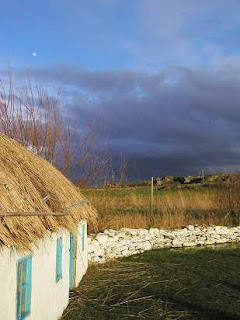
Photo: Straw bale house with natural wood interiors make for a cool house, eliminating the need for air conditioning.

There are some things that I never thought I would have reason to write about. Earthquakes and droughts aren’t a regular occurrence in Inishowen, thank goodness! Another topic that isn’t mentioned much is the need to cool our houses down. I had a letter this week from a woman called Bernie who has been considering getting some air conditioning fitted. Generally speaking we don’t really need air conditioning in our homes and it is usually businesses -big offices, shops and commercial premises that would consider it. After saying that, my mother had the devices fitted to her living room and bedroom and it has made her life a lot more comfortable in the height of summer (she does live in the midlands in England though!). You can pay a lot of money for the units but there are some portable ones you can get from the DIY shops that are all right for a small room and are reasonably priced.
AIR CONDITIONERS
An air conditioner is basically a refrigerator without the insulated box. It uses the evaporation of a refrigerant, like Freon gas, to provide cooling. There has been an outcry recently about these units adding to the global warming problem we hear about. In Ireland we usually use far less electricity in summer than we do in winter. The same cannot be said about the United States. Air conditioners alone use up to 1/6th of U.S. electricity and, on hot summer days, consume 43% of the U.S. peak power load. According to the U.S. Department of Energy, heating and cooling systems in the U.S. emit over a half billion tons of carbon dioxide into the atmosphere each year, adding to global warming. They also generate about 24% of the nations' sulfur dioxide, a chief ingredient in acid rain.
Here are suggestions for free, or low-cost, ways to cool your home with less impact on the environment and your energy bill should you ever decide that it is just too hot in the house!
Blocking the Heat:
The most effective ways to block heat from entering your home are insulation, reflective barriers and shading.
Reflective Barriers:
An important consideration in passive cooling is house colour. Dark-colored home exteriors absorb 70% to 90% of the radiant energy from the sun that strikes the home's surfaces.
hading is the simplest, most effective way to cool your home and reduce energy consumption. Up to 40% of the costs of cooling can be saved by shading techniques such as landscaping with trees and shrubs, and closing the curtains and blinds.
REMOVING INTERIOR HEAT
Thermal Chimney:
If there is any breeze, open the lowest windows on the side from where the breeze is coming. Leave interior doors open, and open the upstairs windows on the opposite side of the house. The warm air in your house will draw upwards and out the upper window, an effect called 'thermal siphoning'. This is most effective when the inside temperature is higher than the outside temperature.
Roof Vents:
Ventilating your attic greatly reduces the amount of accumulated heat which otherwise radiates down into your house.
Ridge Vent:
For even more effective attic ventilation, a continuous ventilation system, Coolvent, can be installed along the ridge, beneath the ridge shingles.
Ceiling Fans:
Ceiling fans are efficient and use little electricity, less than 1/10th the wattage of air conditioners. Ceiling fans can also be used with the air conditioner. This represents a savings of 30% of air conditioning costs and energy consumption.
NATURAL AIR CONDITIONING
There was a technique used or invented by the Romans a long time ago. A natural form of air conditioning / ventilation was used roughly as follows:
A trench 6 to 12 feet deep and 100 to 200 yards long was dug leading from the "house" in a straight line away from the house.
Into this trench a large diameter pipe (these days corrugated drainage pipe 2 or 3 feet diameter) was laid, with holes drilled into the bottom to drain water that condensed inside the pipe. The trench was then covered over.
At the far end a 90-degree elbow was attached and more pipe added so that it reached above ground and the end covered with some sort of wire mesh attached to keep out unwanted things such as rodents, etc., and then another elbow could be added at this end to shield against rain.
The house end of the pipe entered the property and was the source of incoming air.
The key to making this work is to add a convection chimney like I mentioned earlier.
On the outside, two intersecting sides of the chimney; are painted flat black, and then faced south to get the sun.
How it works: the sun heats up the chimney causing the air inside to rise, thus drawing air through the cool pipe. The pipe cools the air drawn from the outside to the temperature of the earth at the depth at which it is buried (which is virtually constant year around at this depth). Of course, without the sun to warm the chimney the system wont be very effective. Get a towel and go for a dip in the sea if you get too hot!
Environmental

No comments:
Post a Comment